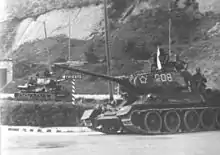Trieste operation
The Trieste operation, also called the Liberation of Trieste, was a battle during the Second World War that took place during early May 1945. It led to a joint allied victory for the Yugoslav Partisans and 2nd New Zealand Division and a joint occupation of Trieste, but relations soon deteriorated and led to a nine-year dispute over the territory of Trieste. This battle is also considered the last battle in which a considerable force of Chetniks fought, as 13,000 of the irregular troops under Momčilo Đujić surrendered to the New Zealand forces under Lieutenant General Sir Bernard Freyberg as the battle progressed.
| Trieste Operation | |||||||
|---|---|---|---|---|---|---|---|
| Part of World War II in Yugoslavia and the Spring 1945 offensive in Italy | |||||||
 Tanks of the Yugoslav 4th Army in Trieste | |||||||
| |||||||
| Belligerents | |||||||
|
|
| ||||||
| Commanders and leaders | |||||||
|
|
| ||||||
| Units involved | |||||||
|
|
| ||||||
| Strength | |||||||
|
|
| ||||||
| Casualties and losses | |||||||
|
436 dead 1,159 wounded |
2,842 killed 3,829–5,200 captured 99 cannons 74 AA guns | ||||||
| 6,500–8,500 civilians killed[1][7] | |||||||
Prelude
Yugoslav Front
The Yugoslavs achieved a breakthrough after a series of hard-fought encounters along the Syrmian Front in late 1944 and early 1945. Present at the pivotal Battle of Knin, the Yugoslav 4th Army then spent most of spring and early summer advancing north through Dalmatia with the intent of taking Trieste without help from Western Allies, thereby justifying a claim to the de jure Italian port.[3]
The 4th Army was led by Petar Drapšin, who had previously led the incorporated 8th Corps until he was promoted to the rank of lieutenant general.
Italian Front
On the Italian front, Western Allied forces advanced towards Trieste after breaching the Gothic Line in early March 1945. Under Lieutenant General Sir Bernard Freyberg, the New Zealand 2nd Division, having captured Faenza on 14 December 1944, reorganized on the south banks of the Senio River on 8 April 1945. There it paused to prepare for what would be the final Allied offensive in Italy. After a brief respite, the division raced on, crossing the Santerno, Gaiana, Idice, and the Po rivers. They took Padua on 28 April, crossing the Isonzo on 1 May and reaching Trieste the next day. The division had covered a distance of 220 km (140 mi) in less than a week.[2]
Battle
By 30 April, the Partisans had surrounded the port city entirely.[6] They began moving on 1 May in with the help of fighters that had infiltrated the city before the arrival of the main force.[3] By 30 April elements of the Yugoslav force had taken multiple strategic locations from Globočnik's force such as the university, courthouse, and military hospital. On the morning of 1 May, parts of the eastern force broke through at Ricmanje and Botač and entered the city. According to Yugoslav reports, resistance had been overcome save a few isolated pockets of Germans, focused around Opčine and the harbor. By the evening of 1 May, Partisans had taken the Elba battery factory and Sabo park, where they were joined by about 50 armed Triestino antifascists. There the 4th Brigade of the 9th Dalmatian Division met and attacked a force of about a thousand German and Chetnik soldiers. On the morning of 2 May this culminated in a two hour firefight followed by the surrender of the enemy force.[4]:281–283,429
By the end of 2 May, with the arrival of the New Zealand force, most of the 13,000 Chetnik irregulars assisting the German defenders surrendered.[8] Fighting lasted into the next day. The remaining German pockets on the north side of the city, the largest of which being the Opčine pocket, surrendered by the end of 3 May.[4]:282–283
Aftermath
The city was jointly occupied by the New Zealanders and Partisans until June 1945, when it came under rule of a UN-mandated military provisional government as a provision of the Treaty of Peace with Italy. It would remain a de-facto free state until it was partitioned between its two neighbors in October 1954. This was later reaffirmed in the Treaty of Osimo, where it was split de jure between Italy and Yugoslavia.[3]
See also
Notes
- Hedges, Chris (20 April 1997). "In Trieste, Investigation of Brutal Era Is Blocked". The New York Times. Retrieved 3 March 2020.
- New Zealand History: Faenza, Trieste, and home
- "Stanford University: The Trieste Crisis"
- Anić, Nikola (2004). Povijest Osmog Korpusa Narodnooslobodilačke Vojske Hrvatske 1943–1945 [History of the Eighth Dalmatian Corps of the Croatian National Liberation Army: 1943–1945] (PDF) (in Croatian). Retrieved 10 March 2020.
- "1966 Encyclopedia of New Zealand: The Army"
- "Vojska.net: Trieste operation"
- San Sabba (2009). "Risiera di San Sabba. History and Museum." Committee of the Nazi Lager of Risiera di San Sabba, Trieste: 3. Retrieved 4 March 2020.
- Binder, David (13 September 1999). "Momcilo Djujic, Serbian Priest and Warrior, Dies at 92". The New York Times. Retrieved 10 March 2020.